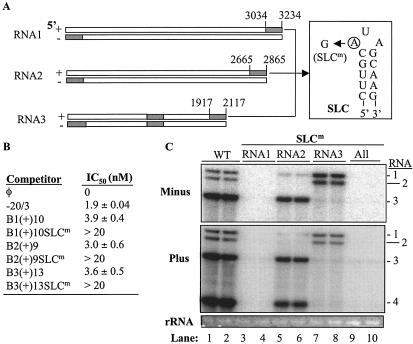FIG. 3.
Roles of SLC in replicase binding and BMV RNA accumulation in barley protoplasts. (A) Schematic representation of the BMV RNAs and the locations of the eight effective replicase-binding sequences. The shaded regions containing SLC are flanked with numbers denoting the nucleotide positions of the RNA fragment. The bars represent BMV RNAs, and the portion of SLC containing the clamped adenine (circled) is shown in the box. The term “SLCm” designates an RNA with a mutation in the clamped adenine. (B) IC50s of a number of RNAs that were used in a template competition assay. RNA −20/3 served as a positive control, and its replicase-binding properties were characterized by Sivakumaran et al. (45). The other RNAs contain the 3′ NCR of the three BMV RNAs (Table 1). SLCm indicates that the clamped adenine was changed to a guanine. (C) Effects of SLC mutations in transfected barley protoplasts. The gel image shows the effect of SLC mutations on genomic minus-strand and genomic plus-strand accumulation. The identities of the most relevant RNAs used in the transfections are shown above the image. “All” indicates that the RNAs were from protoplasts transfected with all three BMV RNAs that had mutated SLCs. The gel image of the 18S rRNAs is intended to show an internal loading control. WT, wild type.

